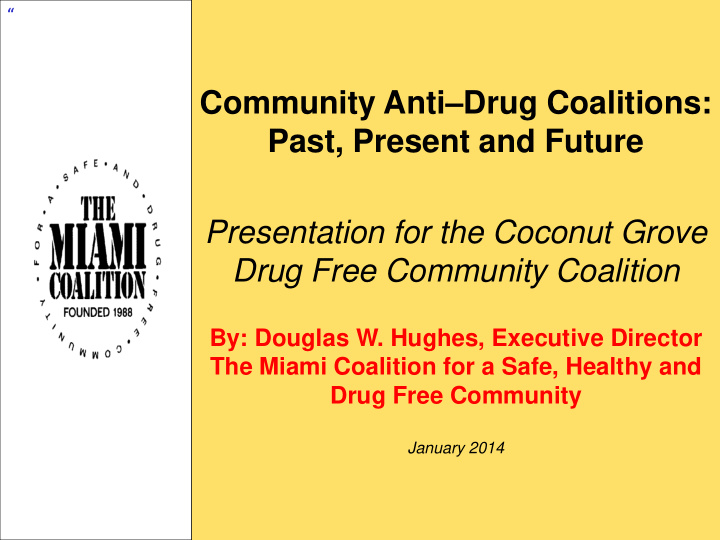



“ Community Anti–Drug Coalitions: Past, Present and Future Presentation for the Coconut Grove Drug Free Community Coalition By: Douglas W. Hughes, Executive Director The Miami Coalition for a Safe, Healthy and Drug Free Community January 2014
Coalitions A committed and organized group/team with different individual agendas but holding a common vision and agreed goals. The work has purpose, cause and leads to effective change for the community Combining strengths and achieving sustainable outcomes.
Coalitions What do they do? Where do they fit? What changes are impacting them? Recommended priorities
Coalitions: What do they do? Convene and mobilize representatives of different community sectors Facilitate discussion Identify community issues Gather supportive data Prioritize and select issues for action Develop a plan Implement the plan Measure outcomes Start Over Again!
Coalitions: Where do they fit? Coalitions do not do direct services: Afterschool programs, repetitively scheduled education classes, etc. Coalitions focus on environmental strategies to change social norms and accomplish population-level changes in behavior: Reduce drug abuse, underage drinking, adult binge drinking and related personal and social consequences
Coalitions: What changes are impacting them? Health Reform - The Public Health Model: Integration of primary care with behavioral health (substance abuse and mental health services); focus on primary prevention to improve health and reduce costs NRC Institute of Medicine Report 2009- Preventing Mental, Emotional, and Behavioral Disorders Among Young People: Progress and Possibilities (MEB-Prevention is Prevention) Florida Department of Children and Families: Contracted with a regional “Managing Entity” (ME), The South Florida Behavioral Health Network, to manage all substance abuse and mental health prevention and treatment funding/services. 2012 approval of a county-wide community needs assessment and Comprehensive Community Action Plan (CCAP)
Coalitions: Changes (continued) Coalitions are central to local capacity building, community data collection, needs and resources assessments, problem identification and analysis, plan development, advocacy, community mobilization, implementing action strategies and the evaluation of prevention service systems and outcomes. Federal and State preference to make community coalitions independent 501(c)3 organizations Federal and State requirements to fund “Evidence-based” programs and “Best Practice” environmental strategies. Funders requiring measurable outcomes for prevention initiatives: What difference does a prevention program or strategy make in population-level behavior, prevalence rates and consequences?
Coalitions: Action Needed Develop strong, sustained, multi-sector coalitions and regularly convene members and community stakeholders Take responsibility for community-level data collection and analysis, plan development, advocacy, action and the evaluation of outcomes Document participation, findings, plans, actions and outcomes Work on sustainability of the local, regional, state and national coalition movement: Position coalitions to take-on responsibilities outlined in national, state and local action plans Demonstrate impact on: substance abuse and related mental health problem prevalence rates, behavioral health consequences, family communication and functioning, high school drop-out rates and overall community stability and safety.
Coalitions As in Politics: All Social Issues and Coalition Priorities are Local!
Recommend
More recommend